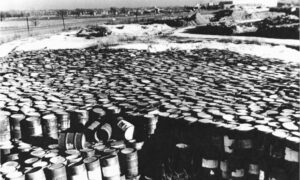18:17
News Story
U.S. Senate OKs Hawley proposal to expand coverage for atomic bomb-related illness to St. Louis
Private companies and the federal government for decades failed to take actions to protect St. Louis residents from nuclear waste, an investigation by The Independent, MuckRock and The Associated Press finds.

An undated photo from the 1980s, of two teenagers stepping on rocks and wooden planks on Coldwater Creek. The photo is from a scrapbook kept by Sandy Delcoure, who lived on Willow Creek in Florissant and donated the scrapbook to the Kay Drey Mallinckrodt Collection (State Historical Society of Missouri, Kay Drey Mallinckrodt Collection, 1943-2006).

The U.S. Senate voted narrowly Thursday in favor of expanding a program that compensates Americans who become ill because of exposure to radiation from the country’s development and testing of nuclear weapons to cover Missourians.
The proposal, offered by Sen. Josh Hawley, was attached as an amendment to the National Defense Authorization Act, which authorizes funding levels and sets policy for the Department of Defense. The bill itself still faces a Senate vote and agreement by the U.S. House of Representatives.
“It is about basic justice — compensating the victims of the federal government’s negligence,” Hawley, a Missouri Republican, said on the Senate floor.
The Senate vote comes on the heels of a six-month investigation by The Missouri Independent, MuckRock and The Associated Press, which found that private companies and the federal government repeatedly downplayed or failed to fully investigate the extent of the contamination from the development of the first atomic bomb.
“This is nothing short of a miracle,” said Dawn Chapman, co-founder of Just Moms STL, which has advocated for cleanup of nuclear waste for a decade. Chapman lauded Hawley during a press call following the vote.
The St. Louis region was pivotal to the development of the bomb during World War II. Workers in downtown St. Louis processed uranium that was used in the first sustained nuclear reaction in Chicago, a major breakthrough of the Manhattan Project.
The development of the bomb still casts a shadow over the region almost 80 years later. Radioactive waste contaminated public lakes and creeks where residents fish and swim. It polluted groundwater and park land. Several sites in St. Louis County still aren’t cleaned up.
Decades later, many St. Louis-area residents believe the radioactive waste is to blame for their rare cancers and autoimmune disorders.
“For decades — decades — they told the people of St. Louis, ‘No problem. There’s no problem here,’” Hawley said. “Meanwhile, children were dying of cancer.”
The program Hawley seeks to amend, the Radiation Exposure Compensation Act, already covers uranium miners and millers as well as those who were onsite and some who lived downwind when nuclear weapons were tested in the Southwest.
Hawley’s amendment would expand the program to cover St. Louis-area residents who develop certain illnesses associated with radiation exposure.
It’s nearly impossible to know with certainty whether a person’s illness stems from exposure to radioactive waste. Expanding the compensation law would make residents eligible so long as they lived in the area during a particular window and developed a covered illness.
U.S. Sen. Eric Schmitt, a Missouri Republican who had yet to speak publicly on the recent reports, grew up near a contaminated site in Bridgeton and backed Hawley’s bill. He said he was proud to support the residents who had been harmed.
“Nothing will make them whole, but this is a step,” Schmitt said.
The amendment needed 60 votes to pass. It passed 61-37 without support from Republican leadership.
Amending the act would also expand coverage, for the first time, to residents of New Mexico.
Even though the first atomic bombs were constructed in Los Alamos, New Mexico, and tested at Alamogordo Bombing Range, civilians weren’t eligible for compensation as “downwinders,” or residents who lived downwind of the testing site. That status was granted to residents in certain parts of Arizona, Nevada and Utah.
The amendment would also expand the law to cover Colorado, Idaho, Montana and Guam and expand coverage to remaining parts of Nevada, Utah and Arizona.
Sen. Ben Ray Luján, a New Mexico Democrat, cosponsored the amendment with Hawley. He asked the Senate to “show these victims compassion, understand their pain and suffering so that they know it’s not gone unnoticed.”
Luján said residents with cancers, asthma and heart problems had traveled to Washington to beg the federal government to expand coverage.
“A few years ago, an elder from the Navajo Nation traveled here to testify, and she looked us all in the eye and she asked a simple question: ‘Are you waiting for us all to die for the problem to go away?’” Luján said.
YOU MAKE OUR WORK POSSIBLE.

A legacy of contamination
Following World War II, nuclear waste from uranium processing was trucked from St. Louis to surrounding counties.
For years, it sat in the open at the St. Louis airport where wind and rain dispersed it. As early as 1949, the company that refined the uranium realized highly radioactive waste sitting in deteriorated drums could pose a threat to Coldwater Creek, a tributary of the Missouri River that winds through what are now busy suburbs.
While sampling conducted for the federal government showed radioactive waste was washing into Coldwater Creek, the public wouldn’t find that out for years.
Countless St. Louis County residents grew up swimming, riding bikes and catching tadpoles in Coldwater Creek. A federal health study shows they now face an increased risk of cancer.
Waste was moved again from the airport to a property in Hazelwood where it continued to pollute Coldwater Creek.
And in 1973, a private company that processed the waste to extract valuable metals dumped the rest at the West Lake landfill where it remains today.
Nuclear waste also sat in the open at a plant in Weldon Spring. The buildings were demolished and buried, along with the radioactive residue, at the site. But state regulators have raised concerns over the years that the groundwater remains polluted.
The sites have come under scrutiny in recent years by environmental activists and state lawmakers.
State Rep. Tricia Byrnes, R-Wentzville, said it was “huge to be heard” after decades of inaction on St. Louis radioactive waste.
“We have a lot of parents who’ve lost children. Children have lost their parents, and unfortunately, we have some families where mom, dad and all of the siblings have died,” Byrnes said. “That is our reality. So I thank you because tonight is so amazing.”
Hawley has extended invitations to U.S. Department of Energy officials to visit St. Louis, which he said has gone unanswered along with requests for additional testing for radioactive materials.
He said it’s “absolutely sickening after what this region has been through and these folks have been through to have the government unwilling to even engage on this issue.”
The amendment was adopted without support from Senate Republican leadership, meaning it could face an uphill climb for final passage. Hawley said he would have to work hard to ensure the language stays in the bill, but he said once someone learns the facts about what happened to St. Louis-area residents, it’s hard to vote no.
“We got this done against all odds today,” Hawley said. “Will there be tough lifts ahead? Yes, there will be — absolutely there will be — and I don’t downplay those for a moment.”
This article has been updated since it was initially published.
GET THE MORNING HEADLINES.
Our stories may be republished online or in print under Creative Commons license CC BY-NC-ND 4.0. We ask that you edit only for style or to shorten, provide proper attribution and link to our website. AP and Getty images may not be republished. Please see our republishing guidelines for use of any other photos and graphics.




